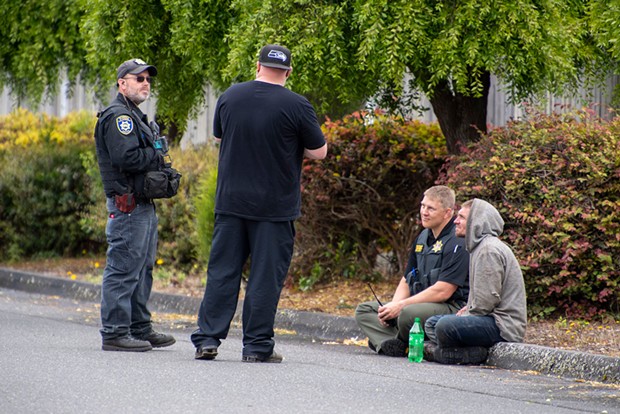[
{
"name": "Top Stories Video Pair",
"insertPoint": "7",
"component": "17087298",
"parentWrapperClass": "fdn-ads-inline-content-block",
"requiredCountToDisplay": "1"
}
]
A can of chewing tobacco, a Sprite and the promise of a meal — that's what it took to bring an hours-long standoff with an armed fugitive to a peaceful end. Well, that and an abundance of patience and calm, underpinned with the steady resolve to give the man every last chance to make the next right decision.
A surreal scene unfolded shortly before 1:30 p.m. on Sept. 10 in the minutes after Matthew Dilley agreed to put down his pistol and surrender to police. As the Humboldt County Sheriff's Office lifted a shelter-in-place order and removed road blocks that had effectively shut down a McKinleyville neighborhood for several hours, Dilley and Undersheriff Justin Braud sat next to one another on a curb, chatting, as Dilley — who multiple officers had held at rifle-point just moments earlier — took a dip and sipped his Sprite. Across the street, Sheriff's Office spokesperson Samantha Karges told the Journal negotiators intended to make good on delivering the items Dilley had been promised in negotiations, and would make a stop at Taco Bell before booking him into jail. It was a moment of humanity, the kind that can be elusively rare in critical incidents.
The day before, a similar situation ended violently. Officers from the Arcata Police Department and the California Highway Patrol had responded to a call about a man walking with a gun near Mad River Road and arrived to find him strolling with a briefcase in hand and a pistol on his hip. According to witnesses, the man refused to put down the briefcase or comply with officers' requests. Over the course of about 15 minutes — and across the span of a quarter-mile as the man kept walking, trailed by a slow moving procession of police cars — the man reportedly refused officers' directives. According to a briefing by Humboldt County Sheriff William Honsal, the man eventually pulled his pistol and brandished it before at least one officer opened fire and fatally shot him.
These incidents came after Robert Anderson was shot and killed by multiple officers in Crescent City on Aug. 25 after he picked up a kitchen knife, lunged at a sheriff's deputy and ran toward a woman standing nearby. Footage from two deputies' body-worn cameras — released by the Del Norte County Sheriff's Office on Sept. 11, after the Journal filed a California Public Records Act request — shows officers giving Anderson space, repeatedly urging him to step away from the knife and to continue talking with them. In a moment of apparent mental crisis, he chose otherwise, with deadly consequences.
As gut wrenching as it is to watch, it's important to note that the video footage released of Anderson's shooting is the only thing that allows us to discuss it with a common set of facts — a clear record of exactly what happened, rather than the kinds of dueling accounts of officers and witnesses that can leave an incident forever shrouded in uncertainty.
And we have Assembly Bill 748, which went into effect in July of 2019, to thank for that, as it requires law enforcement agencies, with limited exceptions, to release video footage of shootings and other use-of-force incidents in which police cause "great bodily harm" to a suspect within 45 days of the incident.
We've written exhaustively in these pages about the value of such videos, arguing that as painful and as awful as they are, their public release is vital to rebuilding the public trust that has obviously splintered over time, both locally and nationally. Allowing a community to see these incidents up close, uncomfortable and complicated as they are, is the only way we can have grounded conversations about them, the only way we can talk meaningfully about not just whether a shooting was justified, but whether it perhaps could have been prevented.
In the coming weeks, we'll have that conversation about the shooting on Mad River Road — a conversation that's only possible because agencies have invested in video technology and lawmakers have mandated they be transparent with the footage that technology yields.
But let us take a moment to be grateful that it's not a conversation we also need to have about Dilley and that, instead, under Braud's command, a steady hand was enough to win the day and save at least one life, that given yet another chance, Dilley finally made the next right decision.
Thadeus Greenson (he/him) is the Journal's news editor. Reach him at 442-1400, extension 321, or [email protected]. Follow him on Twitter @thadeusgreenson.
more from the author
-
Failed Leadership
- May 2, 2024
-
'On Siemens Hall Hill'
How an eight-day occupation at Cal Poly Humboldt divided campus
- May 2, 2024
-
Failed Leadership
- May 1, 2024
- More »
Latest in Editorial
Readers also liked…
-
Failed Leadership
- May 2, 2024
































